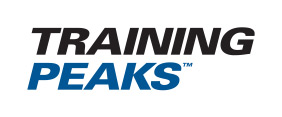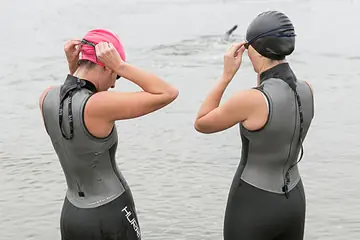
If you ask many athletes and coaches what a good warm-up is the answers will likely vary for each person you ask. Some might say no warm-up is necessary for a longer event like IRONMAN, while others might want a very large and highly detailed warm-up. So what is the perfect warm-up for you and your race? The answer largely depends on three key variables.
1. Goals for the Event
If you are trying to get a Kona or 70.3 Worlds' slot then you must be ready to race hard from the beginning, and that really can't happen without a great warm-up. The higher the goals you have, and the higher the intensity of the race, the more important the little things like warm-up matter.If you are just trying to finish an IRONMAN, then chances are the intensity you are racing at is not something which really requires a significant warm-up for high performance. You just need to be prepared for the conditions of the race.
2. Weather and Water Conditions
If the temperature of the air or water is cold then your body will not respond well to the conditions without a significant warming of the body. Jumping into frigid waters and trying to swim fast does not work well and worse, it brings a risk of hypothermia. You will not be able to generate the heat you need to keep yourself warm if you are not warmed up beforehand.In hot conditions and warm water it doesn't take long to warm up the body at all. Still, a warm-up is necessary to be fully prepared. However, an excessive warm-up might be detrimental since it may cause overheating.
3. Length of Event
There is some truth that the longer the event the less warm-up time is actually needed. Again though, goals and intensity will determine part of this. Even in IRONMAN it is important to get out with the good pack.If you will be starting a race at a very high intensity, say for an Olympic triathlon or if you are trying to win your age group, you must prime the body to be able to get to that intensity right away. Without it, you may get left behind.
Knowing When You're Ready
First, a warm-up should be progressive in nature. It should start off as easier in the earlier stages and build to harder, more race-specific in the later stages with periods of recovery at aerobic intensities. So how much warm-up is enough? Are there any universal truths or tools to know you've warm enough? Yes, and luckily it is a very obvious and simple sign that you are warming up well. It is sweat. If you've broken a sweat then you are priming the body for a good performance. If you continue to sweat despite not exercising, and maintain that feeling of warmth, you have likely reached a good warm up temperature.You'll notice though, I said, "a good warm up temperature," not that the athlete has achieved a good warm-up. Raising the temperature of the body is only one factor in preparing the body for performance. The others are priming the nervous system, the muscular system, and the mind.
Warming Up the Mind
Warming up prepares the mind by calming it, relieving emotional stress and nervousness. A good warm-up should also include mental imagery of reviewing the processes the athlete will execute throughout the race, reassuring the athlete of the plan they have set forth, and how it will be executed. What you are thinking on the start line is likely the biggest determinant of the race result, so ignore the mind's preparation at your own peril.Warming-up the Nervous System
The body can't start a race with high intensity if it hasn't done any high intensity in the warm-up. Your warm-up must include efforts similar to what you will ask of it once the race starts. This doesn't mean if you plan to sprint the first 400 meters of the swim that you must do a number of 400 meter sprints. But it does mean you need to likely do a series of 50 meter sprints, with long recoveries, simulating that first 400 meters.A set of activation exercises before the race, where you wake up the connections between the brain and the key muscle groups you will use in the race are very worthwhile. These short exercises can make a huge difference in performance.
Warming Up the Muscular System
Raising the temperature of the body is only part of warming up the muscular system. There is usually a bit of tension in the fascias and tendons of muscles, and though the warm-up immediately prior to the race will help lubricate these, it can't eradicate many of them. You can probably get even more benefit of the pre-race warm-up by working out the tension in these areas prior to it.When you wake up on race morning, using a foam roller or some type of roller therapy through areas of typical tension spots and key muscle groups for the race will probably enhance and even lower the time demanded for a pre-race warm-up. Just 15 minutes of rolling out some key areas like quads, glutes, hamstrings, hip flexors, calf muscles, pectorals and psoas can do wonders.
This rolling therapy is not intended to be an intense massage as that could damage the muscle tissue and adversely affect the goals of a great warm-up. The aim is to gently going over the areas, with some body weight as pressure, finding some areas of tension and rolling back forth over them to help lubricate the fascia and allow the muscle to move more freely through its range. This type of therapy in the morning hours of the race is beneficial to all athletes, no matter their goals.
Order of Exercises
The order of exercises in the morning should begin with the rolling and dynamic activation movements, then any order of the exercises that you feel most comfortable with. If you have a strong swim background you might not want to run at all and instead extend your swim warm-up. If you are a strong runner you might want to run only and put on your wetsuit and do a few pull sets with bands on the shore. Sometimes riding to a venue makes for a great warm-up opportunity as well since usually bikes are not allowed out of transition once they are placed in it. Again, individual race constraints and conditions may dictate the order, as well as athlete preference. In the end, if you are confident in your execution of preparation, the order of the warm-up won't matter much.
Getting your mind and body ready for the day is the first step to a good day. Follow these guidelines to be prepared to maximize your training and achieve your race goals. Best of luck!
 READ THIS NEXT: How to Use Running Races to Prepare for Triathlon
READ THIS NEXT: How to Use Running Races to Prepare for Triathlon
About the Author










Discuss This Article